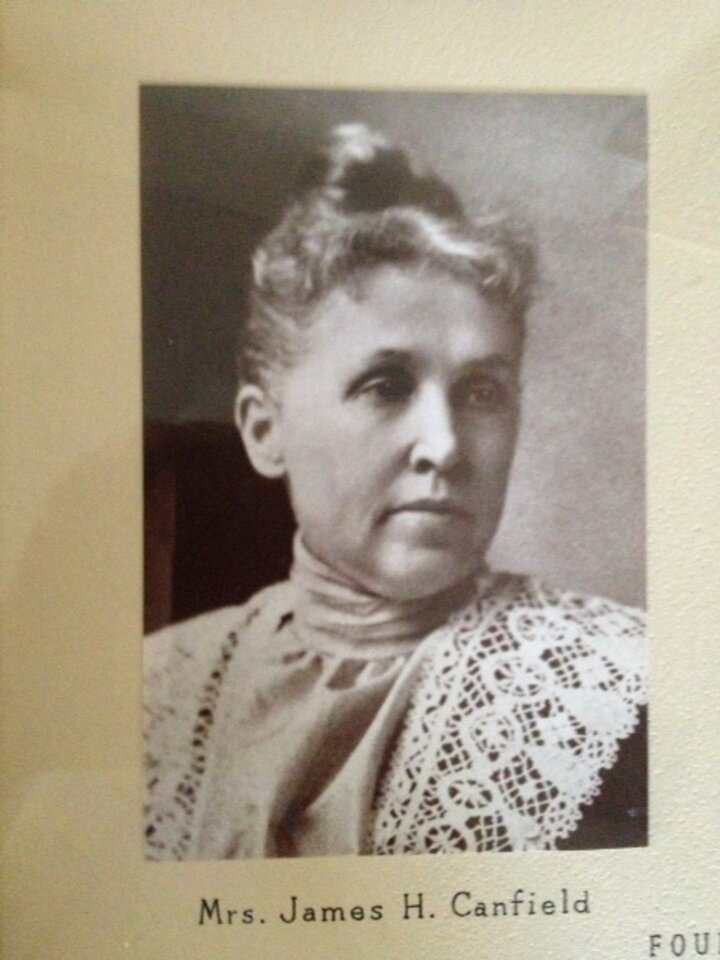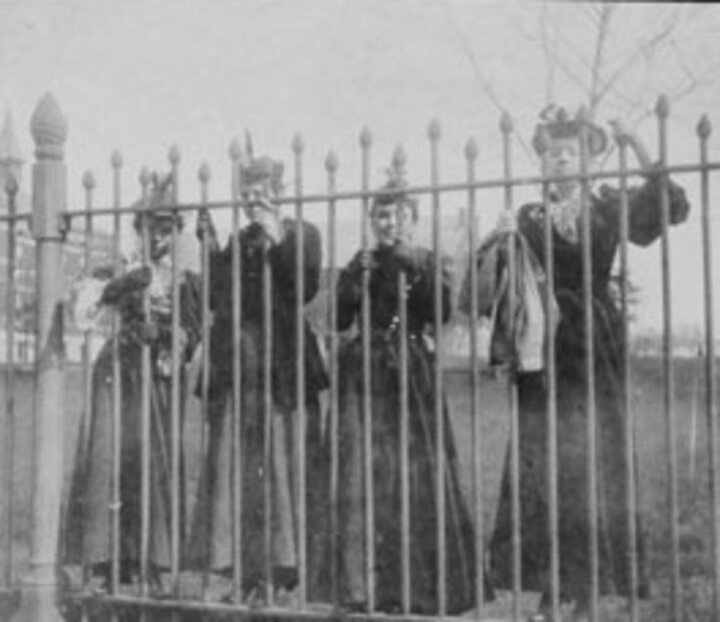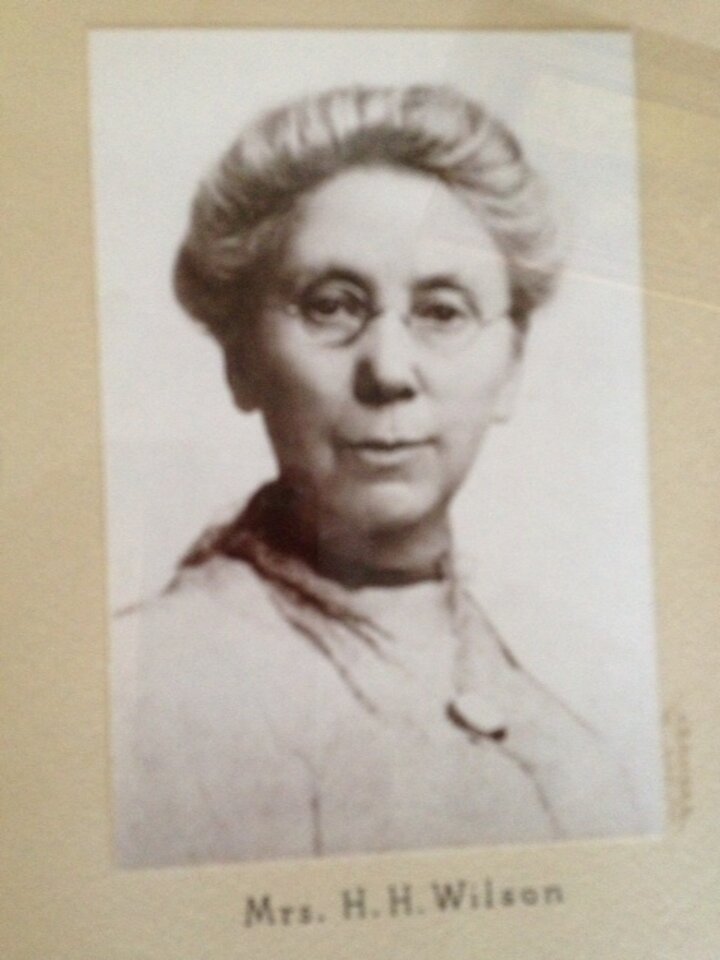The University of Nebraska Women’s Club celebrated 120 years of fellowship and service to the University in November 2014



In March 1867, Nebraska became the 37th state in the Union. Under the Morrill Act of 1862, Nebraska had three years to accept the act and two more years to open a land-grant university. In 1869 a university charter was written and passed by the legislature. By the fall of 1872 the University of Nebraska had 123 students.
It was shortly after the opening of the University that the faculty women were invited to meet at the home of Mrs. James H. (Flavia) Canfield (Chancellor -November 1894) to consider forming themselves into a club. The hostess presided and it was moved and seconded that a club should be created. Mrs. Canfield, Mrs. Charles Henry (Harriet) Morrill (regent) and Mrs. Erwin (Margaret) Barbour (University museum) were appointed to prepare a constitution and by-laws. The object of the club was “to stimulate intellectual and moral development, to promote good fellowship among its members and to foster social life at State University of Nebraska”. On November 28, 1894 the faculty women met at the home of Mrs. Charles Edwin (Lucy) Bessey (Botany/Dean) and the constitution and bylaws were read and approved. This concept has been carried forth to the club as it exists today!
Flavia Canfield went on to champion the nation-wide woman’s club movement both through establishment of the Nebraska State Federation of Women’s Clubs and her later similar activities in Ohio and at The Ohio State University. Within a little over one month of her arrival in Ohio she had encouraged the formation of a group similar to the one she help start in Nebraska. Many of these initial members from Nebraska went on to other colleges and universities to help establish similar groups at their new schools.
It is through this background of the early start of the University of Nebraska Women’s Club that the club went on to create a rich history of activities and service to the University.
Groups similar to the one at the University of Nebraska are in existence at all Big Ten schools, Nebraska’s club being the earliest.
- University of Nebraska Women’s Club, University of Nebraska, November, 1894
- University Women’s Club of The Ohio State University, Fall 1895
- University League, University of Wisconsin, 5/4/1901
- The Illinois Club, The University of Illinois, February 1906
- Faculty Women’s Club, Indiana University, May 22, 1913
- University Circle, Northwestern University, 1915
- University Club at The University of Iowa, September 1917
- Faculty Women’s Club at the University of Michigan October 26, 1921
- Purdue Women’s Club, Purdue University, 3/16/1922
- MSU Community Club, Michigan State University, 1923
- University Women’s Club, Penn State University, 1928
Activities of the University of Nebraska Women’s Club
One of the first activities of the club was to serve a supper to the University football team, the Bugeaters. In 1895, it was decided that the club would give monthly receptions for University students. These gave way to receptions every three months, then one per year between semesters. Recently the Club showed support for the needs of University students with a gift of a student study chair to the C. Y. Thompson Library on the East Campus.
By 1901 it was suggested that the club devote a portion of its funds towards helping young women in the University who are “sick and helpless”. With students in Lincoln, often a great distance from their families and with those travel times long, students found themselves in the position of needing immediate financial help with nowhere to turn. The Women’s Club was there to help. Club minutes later note that the majority of this help was repaid as soon as family or friends were able to reach their students.
In addition to this work, the club was very involved in the community. One important project in the earlier years involved working with the local YWCA and YMCA. These organizations provided extra support vital to students who were located a long way from home. Another of the special projects of the YWCA and YMCA was the so-called “settlement house” initially located at 18th and X Street, then moved to 20th and N Streets. Here volunteer students assisted newly arrived immigrants, particularly the German Russian people, in adjusting to their new environment. Sewing and cooking classes were given as well as crafts and recreational activities. February, 1933 found the club forgoing their usual spring party and instead giving the money to the YWCA. More support for the University YWCA came in the form of a 1934 benefit play given by the Faculty Women’s Dramatic Club (started in 1930). More recently, in 2006 the Club sponsored “The Starburst”, a piece of artwork created by UNL Women’s interest group The Piecemakers. The funds derived from this citywide project went to support the Lincoln YWCA.
The club’s response to the needs of the community was recognized In April 2007 with the prestigious President’s Volunteer Service Award for over 4,000 hours of work with the valuable Meals on Wheels program. Since that award in 2007, many more hours have been given to the Meals on Wheels program by members of the club.
The club met regularly in Ellen Smith Hall at 14th and R Street from about 1920 through the forties. It was one of six houses built in the 1880s that were purchased in 1913 as women’s buildings. Ellen Smith Hall could accommodate large groups of people with a substantial reception room, drawing room, parlor and court. The building was used as a center for women’s activities and the club helped equip the building by providing serving pieces, a piano and other items. The Newcomers group of the Club presented a history of Ellen Smith Hall as one of the club’s programs in 1945. Members of the group wore gowns representing the 1890’s.
In 1937, the first secretaries’ book from 1894-1920 was placed in the archives of Love Library. Prior to this, it had been feared that the information was lost. Now historical materials pertaining to the club are archived at the University’s Love Library for safe-keeping with minutes available for scrutiny going back to that first meeting in 1894.
The influence of changing times on the club
Faculty Women were politically active and many of the club program’s emphasizes were influenced by world events and changing times.
In 1907 one of the year’s programs related to the women’s suffrage movement among collegiate women. Meetings were cancelled due to an epidemic of smallpox in 1910. By 1913 dues were raised from 50 cents to 75 cents, with dues at $1.00 by 1935. In 1917, the president of the club called the ladies’ attention to the course being offered in suffrage, civil government and public speaking. During that same year the women met to do Red Cross work, rolling bandages and other things needed to support the troops during World War I.
History seemed to repeat itself as World War II came along and once again influenced the club’s activities. In 1941 no annual tea was held because of the outbreak of WWII. Following the lead of the general population, the club purchased war bonds in support of the country. In 1943 club members were again encouraged to help with surgical dressings to be sent overseas as they had done during WWI.
By 1956, the subject of polio and its effect on the health and activities of the country were addressed. Also during this time, the club asked members to write to the existing three networks asking for improvement of TV programming during any hours children might be watching. The influence of this new medium was being watched with concern. The program for November, 1977 was titled “The Displaced Homemaker”, a response to the changing place of women in the world.
Club support for students at the University
In addition to scholarships, support for the student population took the form of a thrift shop organized in 1959 where only University students could shop. Proceeds from the shop went into an emergency student loan fund.
For many years, an important source of income for the scholarship fund came from running the ASUN and Homecoming elections on campus by the club.
The quilting group within the club has been very active in supporting the scholarship fund with raffles for a quilt and later held a quilt show with 1,050 people attending and the funds boosting the scholarship fund. To this day, they continue to provide lovely items for various events.
A major boost to the Endowment Fund for scholarships came in the spring of 2014 with the largest fundraiser ever. Twenty handsome Adirondack chairs were hand crafted by the husband of a club member. These were then transformed into works of art by various groups and displayed at local venues. A gala was held with a silent and live auction that netted over $28,000 in additional funds.
- In 1924, the first scholarships ($50 each) were presented by the club to each of two women beginning a long standing tradition that carries to this day.
- In 1935, it was reported that 20 women had been assisted to the extent of $1,025 by the club.
- In 1946, three $50.00 scholarships were given.
- By 1947, the scholarship committee announced that 57 women had received scholarships.
- In 1949, the first $100 scholarship was awarded. In recognition of this award the “Rag” (nick name for the UNL school paper) wrote “we feel that the University Faculty Club deserves special thanks for the $100 scholarship it gives each year. At a time when faculty members are far from the highest paid people in the world, their wives certainly are to be commended for giving extra thought and money to the University and its students”.
- In 2013, UNL Women’s Club granted a total of 10 scholarships at $1,000 each.
- In the 2021-2022 academic year, UNL Women's Club will award $25,000 in scholarships.
In 1932 we see the first mention of “Newcomers”. By 1955 there were ninety-eight newcomers in the club consisting of a total of 255 members. Faculty Newcomers published a cookbook in 1973 with proceeds going into the scholarship fund. In 1977/78 Newcomers and Faculty Women’s Club had combined their yearbooks and in 1983 Newcomers became an interest group.
In 1994, in recognition of the first 100 years of the club’s existence, a cookbook titled “Refreshments with Permission” was created. Proceeds from this project were used to cover the cost of restoration of “World Peace”, the Elizabeth Dolan*mural in the women’s lounge on the first floor of the student union on the University of Nebraska-Lincoln city campus. The restoration of the painting was felt to be an appropriate gift to past and future students of the University of Nebraska-Lincoln. This project paralleled the club’s previous interest in saving art from war-torn Europe during World War II.
In 2017, the UNL Women’s Club added another philanthropy project, providing donations to the Husker Pantry. The Pantry is a resource for students who struggle with food and/or shelter insecurity. It is located on the first floor of the University Health Center, is available to all students, and items are free of charge. UNLWC members have donated items at UNLWC events and the Club periodically holds donation drives.
In the fall of 2020, a team of UNLWC sewers made and delivered 280 handmade Covid masks to UNL in September. They were distributed to the Husker Pantry and extension offices throughout the state and by the health agencies they work with citing a lack of resources in rural areas. This project was done at no cost to UNLWC while at the same time spreading good will and community concern with the “Sewn by the UNL Women’s Club” label.
Fall and spring programs
A fall welcome tea was initiated in the early years by the club and that concept has continued annually. This event has typically been hosted by the spouse of the University President in their home. This event is always well attended and is a valuable way for club members to meet new members and to sign up for various interest groups. Club members look forward to this opening event each year.
In addition to the fall tea, over the years members have joined one another in the enjoyment of an annual gathering in the spring. In the early years, the group often enjoyed a picnic, sometimes inviting spouses. It was held on the Farm Campus grounds for several years. Later this event evolved, most often as a style show, with proceeds from the event supporting the growth of scholarship funding. The theme has varied over the years from a presentation of garments made by members themselves, to original design garments by the students from the University Home Economics program to a style show with a circus theme and later, a show of vintage bridal gowns. Attendees have been transported to “April in Paris”, have been encouraged to “Spread Your Wings” and spent “One Enchanted Evening” dining and dancing.
Many of the club programs have utilized the talents of University students. The music department has been a strong source of inspiring programs through the years. In 2009 the spring program involved a high tea with the event served by students in the Professional Golf Management program at the University.
With this variety of themes, the club’s original goals of fostering good fellowship among its members while also increasing our ability to support University students certainly have been met.
Throughout the 127 years of the club, the membership has remained true to the original aims of that first group of women who saw a need for helping wherever a need was found. We look forward to another successful 127 years.
*Elizabeth Dolan 1871 – 1948 Known for mural “World Peace” and “The Spirit of the Prairie” (1930 – Nebraska State Law Library). She also created frescoes in Morrill Hall.